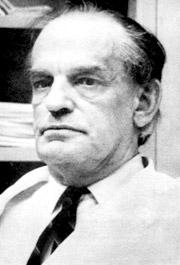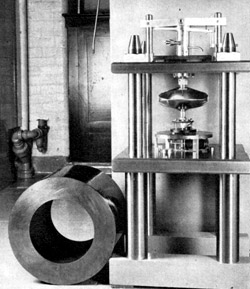Developing a Novel Vaccine Against Yellow Fever That Remains Important Seventy Years Later

Theiler, Max
By 1930, the year that Max Theiler (1899-1972) arrived at the Rockefeller Foundation's International Health Division laboratories on the Rockefeller Institute campus, yellow fever was known to be a viral disease transmitted by Aedes aegypti mosquitoes. Controlling these mosquitoes reduced outbreaks of the disease, but a vaccine was needed to eliminate it. Theiler already was at the forefront of yellow fever research. He had disproved the claim of Rockefeller's Hideyo Noguchi that a spirochete was responsible for the disease, and he had shown that the West African and South American strains produce the same immunological response. In addition, just before moving to the Rockefeller campus, Theiler had made an important advance: he demonstrated that yellow fever could be propagated in mice. Previously researchers had used rhesus monkeys as animal models of the disease, but with mice—inexpensive and prolific—Theiler was poised to make rapid progress toward a vaccine.
The Rockefeller Institute was a world-renowned center for virus research in the 1930s. Theiler continued his mouse studies in the Rockefeller Foundation laboratories, finding that the yellow fever virus became less virulent in monkeys after many passages through mouse brain. He also cultivated the virus in tissue culture, working with Eugen Haagen. Tom Rivers, an eminent virologist at the Rockefeller Hospital, had with Haagen developed an attenuated strain of vaccinia virus a few years before, for use as a smallpox vaccine, and in informal conversations Rivers had suggested this as a research path toward the yellow fever vaccine.

The ultracentrifuge used in recent studies on yellow fever. From Yellow Fever by Strode, G., 1951
Theiler experimented with several strains of the yellow fever virus, passing them hundreds of times in different kinds of tissue culture and testing them for the ability to attack the nervous system—a property of the virus that needed to be eliminated to make a safe vaccine. In 1937 these studies succeeded when a strain known as the Asibi strain underwent a change that rendered it harmless. This became the basis of a live vaccine of attenuated virus, known as the 17D strain, that was field tested in Brazil the next year. Since then hundreds of millions of doses of the yellow fever vaccine have been given, and the methods for producing it have remained essentially the same as those Theiler developed. For his discoveries concerning yellow fever and how to combat it, Theiler was awarded the Nobel Prize in 1951.
Max Theiler studied at the University of Capetown Medical School, and later at the London School of Tropical Medicine, where he was awarded a diploma of tropical medicine and hygiene in 1922. That year he became a Licentiate of the Royal College of Physicians and a member of the Royal College of Surgeons, and joined the department of tropical medicine at Harvard Medical School. In 1930 he moved to the International Health Division of the Rockefeller Foundation, to a laboratory on the campus of the Rockefeller Institute. He remained with the Rockefeller Foundation, becoming in 1951 the director of laboratories of the foundation's Division of Medicine and Public Health, New York. In addition to the Nobel Prize (1951), Theiler's work was recognized by the Chalmer's Medal of the Royal Society of Tropical Medicine and Hygiene (London, 1939), the Flattery Medal (Harvard, 1945), and the Lasker Award (1949).
Selected Publications
Theiler M and Sellards AW. Immunological relationship of yellow fever as it occurs in West Africa and South America. Ann Trop Med, 1928, 22: 449-460
Theiler M. Susceptibility of white mice to the virus of yellow fever. Science, 1930, 71: 367
Theiler M. Studies on the action of yellow fever virus in mice. Ann Trop Med Parasit, 1930, 24: 249-272
Theiler M and Haagen E. Studies of yellow fever virus in tissue culture. Proc Soc Exp Biol Med, 1932, 29: 435-436
Theiler M and Smith HH. The effect of prolonged cultivation in vitro
upon the pathogenicity of yellow fever virus. J Exp Med, 1937, 65:
767-786
http://jem.rupress.org/cgi/reprint/65/6/767
Theiler M and Smith HH. The use of yellow fever virus modified by in
vitro cultivation for human immunization. J Exp Med, 1937, 65: 787-800
http://jem.rupress.org/cgi/reprint/65/6/787
Further Reading
Norrby E. Yellow fever and Max Theiler: the only Nobel Prize for a virus vaccine. J Exp Med, 2007, 204: 2779-2784
http://jem.rupress.org/cgi/reprint/204/12/2779
Post PR, de Carvalho R, da Silva Freire M, and Galler R. The early use
of yellow fever virus strain 17D for vaccine production in Brazil - a
review. Mem Inst Oswaldo Cruz, 2001, 96:849-857
http://www.scielo.br/pdf/mioc/v96n6/4190.pdf
Links
The Nobel Prize in Physiology or Medicine, 1951
http://nobelprize.org/nobel_prizes/medicine/laureates/1951/index.html
